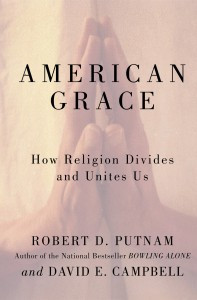
American Grace: How Religion Divides and Unites Us
Robert D. Putnam & David E. Campbell
673 pages, Simon & Schuster, 2010
For those who follow American public intellectual life, Robert Putnam is best known for his 2000 book Bowling Alone, in which he argued that a key problem with contemporary American civic life was the decline in memberships in voluntary associations. Using mountains of data, Putnam demonstrated declining levels of memberships in groups such as the Elks and Rotarians, civic improvement groups, and even bowling leagues. According to Putnam’s formulation, participation in groups brings people into contact with others, creates relationships of trust that foster “social capital,” and produces a sustained concern with public life. The organizational demise of voluntary associations ramifies throughout the culture to isolate individuals and block avenues for pursuing the common good.
One voluntary association that has remained vibrant, however, is the religious congregation. More Americans belong to religious congregations than any other type of organization. Therefore, Putnam and his colleague David Campbell focus on the religious lives of Americans, particularly as expressed in congregations. They are interested in how religion divides and unites Americans, and in the tolerance that is fostered through inter-religious engagement, providing a “grace” that contains great hope for society.
Putnam and Campbell use a nationally representative survey and site visits with a dozen congregations to try to get at both the statistical breadth of American religiosity and the varied ways it happens “on the ground.” They present the now-standard narrative of postwar American religion—that the social and cultural changes of the 1960s, and reactions to them, led to a split in American religious and political life. Religious conservatives and liberals have polarized, even within denominational groups. And those who are highly involved with their religious community—by attending worship services often, for example—have become more conservative. So a division between highly involved conservatives, on the one hand, and liberals and the nonreligious, on the other, has left a shrinking “moderate middle.”
But Putnam and Campbell also show that interpersonal religious tolerance and religious diversity have grown. How does polarization coexist with such diversity? The polarized clusters are apparently not accompanied by religious segregation. Rather, the fluidity of American religion that helped foster these divisions also encourages switching and connecting across them. Most people know someone of a different faith through extended family. The authors call this the “Aunt Susan Principle,” and claim it is “the most important reason that Americans can combine religious devotion and diversity.” A corollary, the “My Friend Al Principle,” reflects interfaith ties in non-family social networks, or through shared interests. The authors find that such bridging produces a slight, but general, religious tolerance and softens the potentially destructive aspects of religious divisions.
The role that organizations, specifically congregations, play in this story is not simple. The fluidity of religious involvement, and its intrinsic voluntarism, means that congregations have increasingly become places for the like-minded. Such homophily pushes clerical leadership to pander to the views of congregants, as the latter can “vote with their feet” if the place makes them uncomfortable. It is one reason that the authors find little overt politicking in churches—there may be subtle attitudinal shaping, but directive teaching or actual political mobilization risks alienating some members.
And yet Putnam and Campbell show that things are changing. Many churches have adapted to the advent of women’s equality, and although still overwhelmingly racially segregated, they are becoming less so. Clergy aware of the need to keep members have found that direct politics doesn’t help, so they encourage a type of practical tolerance and develop ways to interpret and present their faith. And when different types of people find themselves in the same congregation, the contact there fosters the good neighborliness and respect for diversity that the authors admire in American religion.
That said, there are fewer organizational lessons in the book than I expected. For a study predicated on the importance of associational belonging and network connections among groups, it gives overwhelming attention to individual-level data. The congregation vignettes are interesting and illustrative; they make the book a more engaging read. But this isn’t an organizational analysis of American religion, or one full of insights from organizational insiders. It is pretty standard—though very well done—survey-based social science about attitudes and behaviors.
American Grace is an optimistic book, and there is good reason for that. Compared with many places, Americans manage religious diversity pretty well and seem to be getting better at it. But it is important not to underestimate how religion divides Americans and is still intertwined with inequality and social conflict. Religion has adapted to, rather than led, most social justice-oriented change. And the book’s thesis is that social contact and familiarity help produce religious tolerance, not any particular theological doctrine. (Indeed, the most highly religious 10 percent are less tolerant.)
A common wisecrack about American religion is that it is “a mile wide but an inch deep.” That may also apply to American religious tolerance. Tolerance for diversity is not “pluralism”; as the controversy over an Islamic community center in lower Manhattan demonstrated, it often doesn’t take much to rile up animosities. Historically, acceptance of religiously marginal groups has depended on their adaptation to American Protestant middle-class culture. That largely remains the case.
Religion is not going away in our national culture, so it is reassuring to read a highly researched, clearly thought-out argument about why religious adherence and diversity continue to serve American society positively. This will be important to keep in mind on those days when news events reflect humankind’s darker side.
Rhys H. Williams is professor and chair of the department of sociology at Loyola University Chicago, where he also directs the McNamara Center for the Social Study of Religion.

